Abstract
AIM: To investigate the correlation between androgen receptor expression and fibroblast growth factor 8 (FGF8) mRNA levels. METHODS: 39 human prostate cancers and 14 benign prostatic hypertrophy specimens were examined immunohistochemically for androgen receptor expression and by in situ hybridisation and reverse transcription polymerase chain reaction for FGF8 expression. RESULTS: In 39 tumours there was a statistically significant negative correlation between tumour grade and FGF8 expression and a positive correlation between FGF8 and androgen receptor expression. All 14 benign hypertrophy specimens expressed moderate to high levels of FGF8 and androgen receptor. CONCLUSIONS: Loss of FGF8 may be a factor involved in the development of prostatic cancer.
Full text
PDF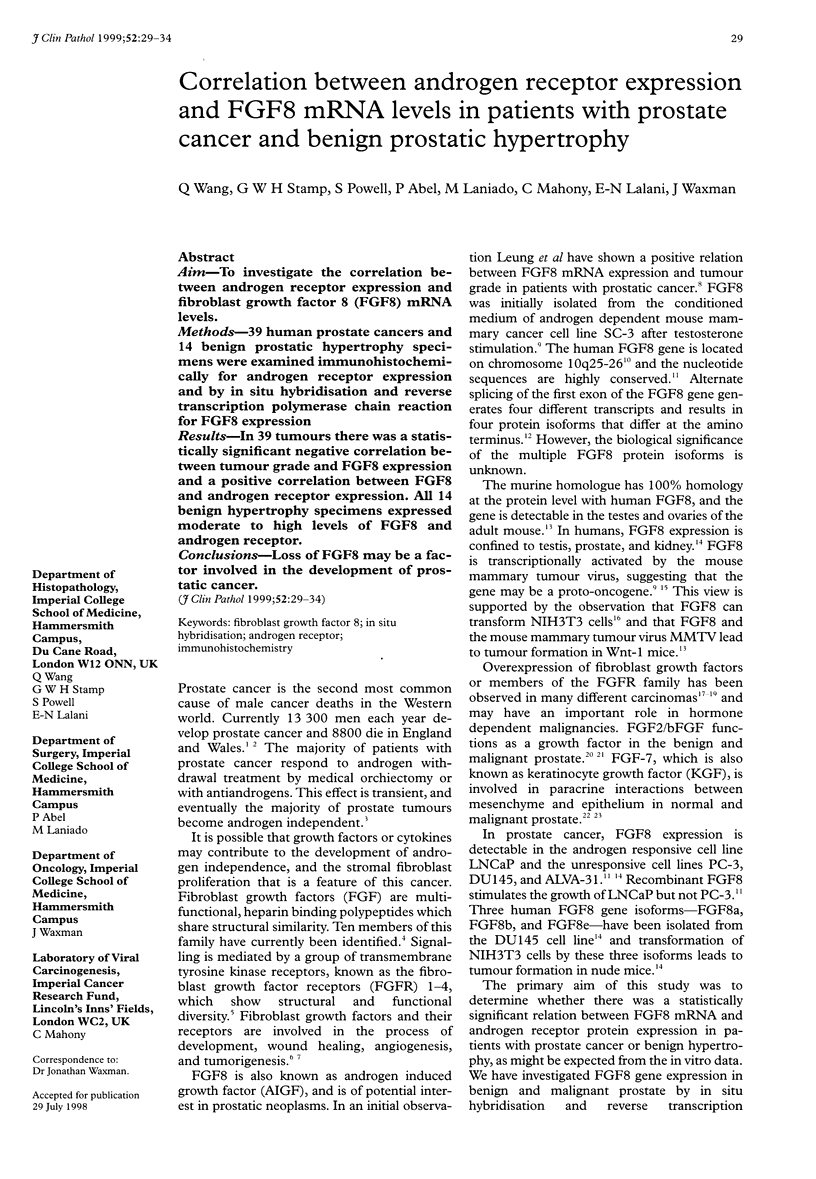
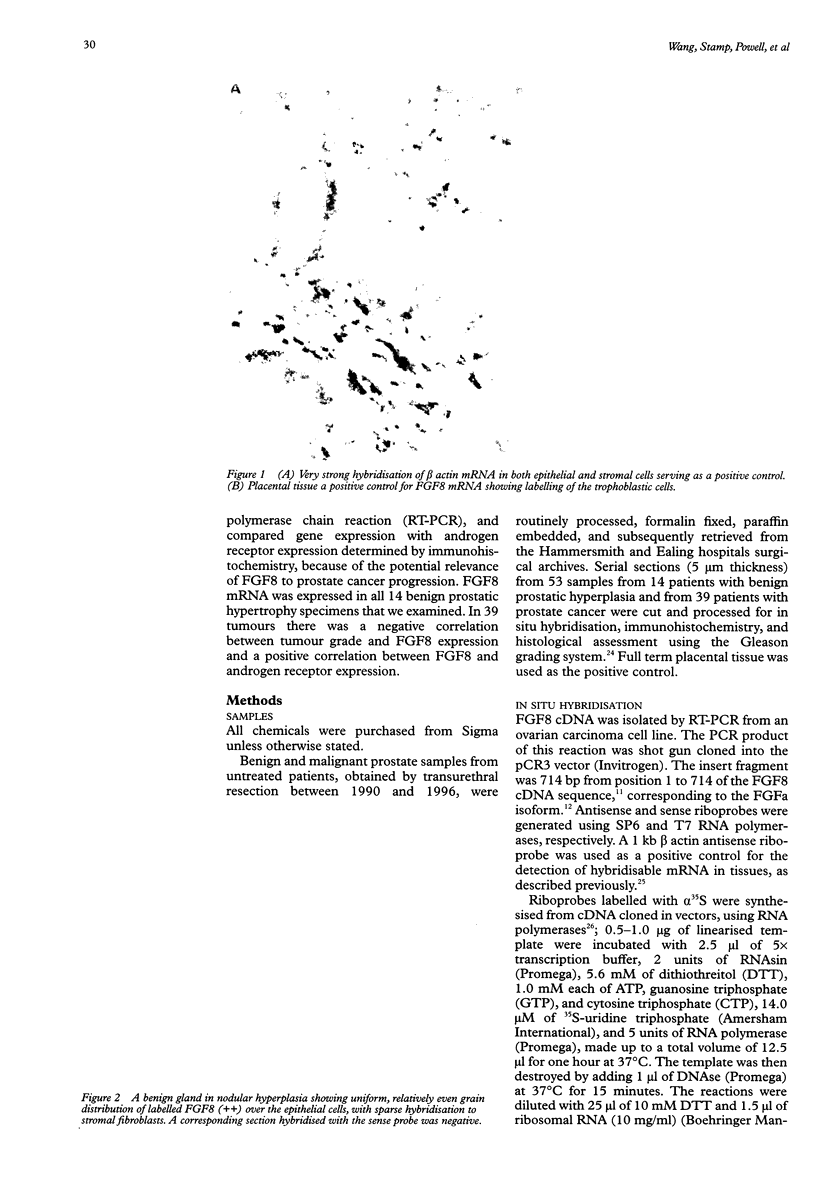
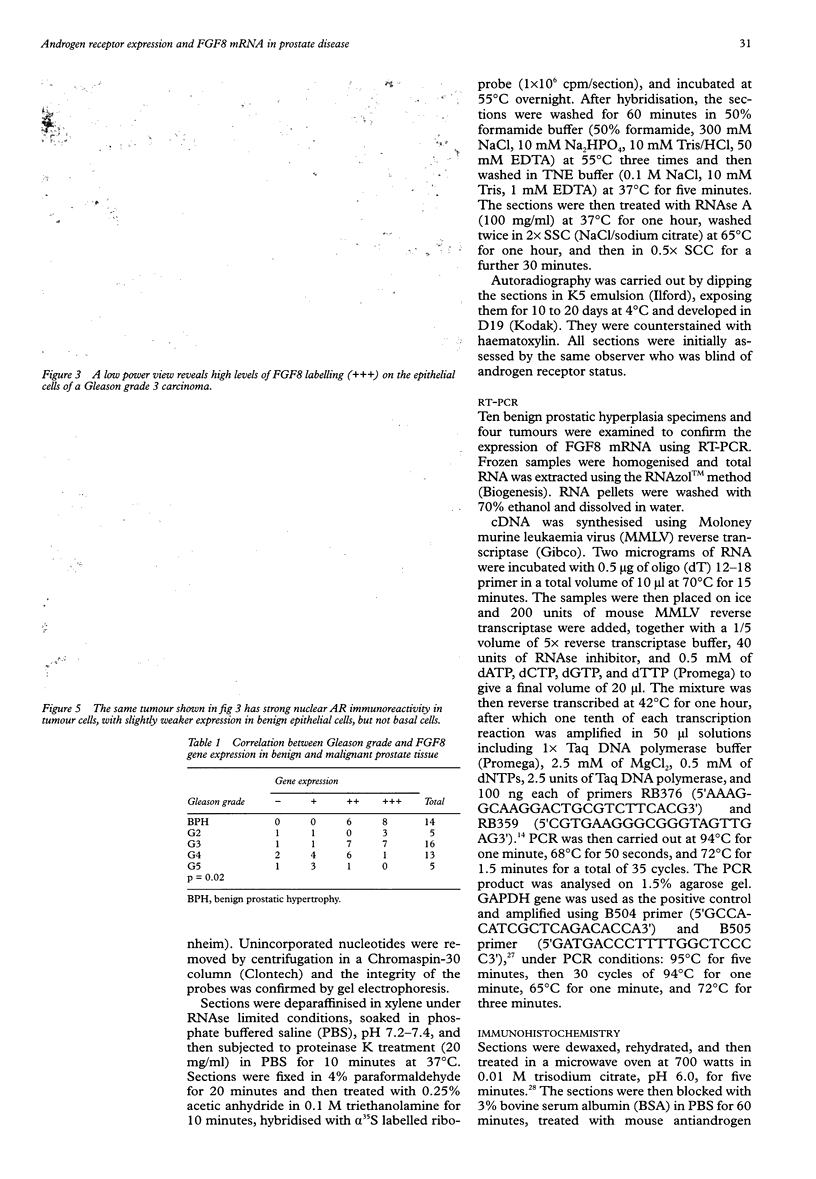

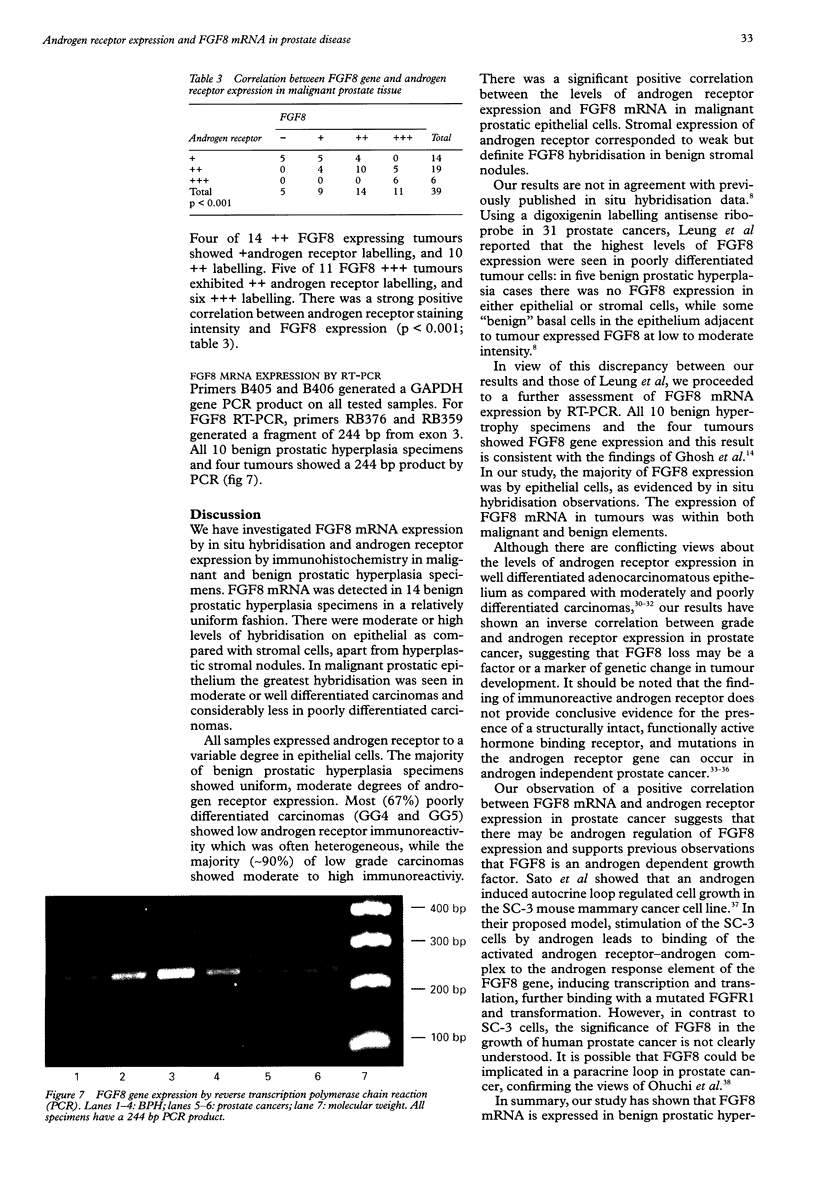
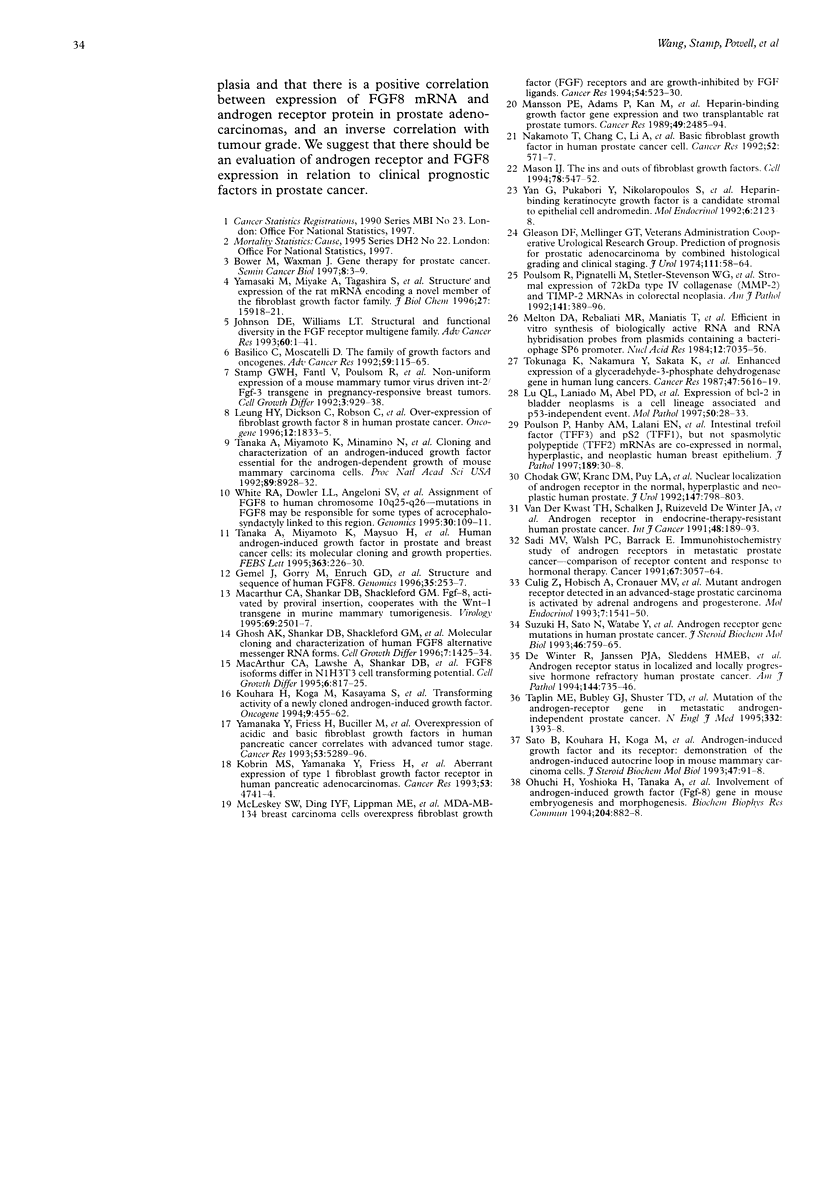
Images in this article
Selected References
These references are in PubMed. This may not be the complete list of references from this article.
- Bower M., Waxman J. Gene therapy for prostate cancer. Semin Cancer Biol. 1997 Feb;8(1):3–9. doi: 10.1006/scbi.1997.0055. [DOI] [PubMed] [Google Scholar]
- Chodak G. W., Kranc D. M., Puy L. A., Takeda H., Johnson K., Chang C. Nuclear localization of androgen receptor in heterogeneous samples of normal, hyperplastic and neoplastic human prostate. J Urol. 1992 Mar;147(3 Pt 2):798–803. doi: 10.1016/s0022-5347(17)37389-5. [DOI] [PubMed] [Google Scholar]
- Culig Z., Hobisch A., Cronauer M. V., Cato A. C., Hittmair A., Radmayr C., Eberle J., Bartsch G., Klocker H. Mutant androgen receptor detected in an advanced-stage prostatic carcinoma is activated by adrenal androgens and progesterone. Mol Endocrinol. 1993 Dec;7(12):1541–1550. doi: 10.1210/mend.7.12.8145761. [DOI] [PubMed] [Google Scholar]
- Gemel J., Gorry M., Ehrlich G. D., MacArthur C. A. Structure and sequence of human FGF8. Genomics. 1996 Jul 1;35(1):253–257. doi: 10.1006/geno.1996.0349. [DOI] [PubMed] [Google Scholar]
- Ghosh A. K., Shankar D. B., Shackleford G. M., Wu K., T'Ang A., Miller G. J., Zheng J., Roy-Burman P. Molecular cloning and characterization of human FGF8 alternative messenger RNA forms. Cell Growth Differ. 1996 Oct;7(10):1425–1434. [PubMed] [Google Scholar]
- Gleason D. F., Mellinger G. T. Prediction of prognosis for prostatic adenocarcinoma by combined histological grading and clinical staging. J Urol. 1974 Jan;111(1):58–64. doi: 10.1016/s0022-5347(17)59889-4. [DOI] [PubMed] [Google Scholar]
- Johnson D. E., Williams L. T. Structural and functional diversity in the FGF receptor multigene family. Adv Cancer Res. 1993;60:1–41. doi: 10.1016/s0065-230x(08)60821-0. [DOI] [PubMed] [Google Scholar]
- Kobrin M. S., Yamanaka Y., Friess H., Lopez M. E., Korc M. Aberrant expression of type I fibroblast growth factor receptor in human pancreatic adenocarcinomas. Cancer Res. 1993 Oct 15;53(20):4741–4744. [PubMed] [Google Scholar]
- Kouhara H., Koga M., Kasayama S., Tanaka A., Kishimoto T., Sato B. Transforming activity of a newly cloned androgen-induced growth factor. Oncogene. 1994 Feb;9(2):455–462. [PubMed] [Google Scholar]
- Leung H. Y., Dickson C., Robson C. N., Neal D. E. Over-expression of fibroblast growth factor-8 in human prostate cancer. Oncogene. 1996 Apr 18;12(8):1833–1835. [PubMed] [Google Scholar]
- Lu Q. L., Laniado M., Abel P. D., Stamp G. W., Lalani E. N. Expression of bcl-2 in bladder neoplasms is a cell lineage associated and p53-independent event. Mol Pathol. 1997 Feb;50(1):28–33. doi: 10.1136/mp.50.1.28. [DOI] [PMC free article] [PubMed] [Google Scholar]
- MacArthur C. A., Lawshé A., Shankar D. B., Heikinheimo M., Shackleford G. M. FGF-8 isoforms differ in NIH3T3 cell transforming potential. Cell Growth Differ. 1995 Jul;6(7):817–825. [PubMed] [Google Scholar]
- MacArthur C. A., Shankar D. B., Shackleford G. M. Fgf-8, activated by proviral insertion, cooperates with the Wnt-1 transgene in murine mammary tumorigenesis. J Virol. 1995 Apr;69(4):2501–2507. doi: 10.1128/jvi.69.4.2501-2507.1995. [DOI] [PMC free article] [PubMed] [Google Scholar]
- Mansson P. E., Adams P., Kan M., McKeehan W. L. Heparin-binding growth factor gene expression and receptor characteristics in normal rat prostate and two transplantable rat prostate tumors. Cancer Res. 1989 May 1;49(9):2485–2494. [PubMed] [Google Scholar]
- Mason I. J. The ins and outs of fibroblast growth factors. Cell. 1994 Aug 26;78(4):547–552. doi: 10.1016/0092-8674(94)90520-7. [DOI] [PubMed] [Google Scholar]
- McLeskey S. W., Ding I. Y., Lippman M. E., Kern F. G. MDA-MB-134 breast carcinoma cells overexpress fibroblast growth factor (FGF) receptors and are growth-inhibited by FGF ligands. Cancer Res. 1994 Jan 15;54(2):523–530. [PubMed] [Google Scholar]
- Melton D. A., Krieg P. A., Rebagliati M. R., Maniatis T., Zinn K., Green M. R. Efficient in vitro synthesis of biologically active RNA and RNA hybridization probes from plasmids containing a bacteriophage SP6 promoter. Nucleic Acids Res. 1984 Sep 25;12(18):7035–7056. doi: 10.1093/nar/12.18.7035. [DOI] [PMC free article] [PubMed] [Google Scholar]
- Nakamoto T., Chang C. S., Li A. K., Chodak G. W. Basic fibroblast growth factor in human prostate cancer cells. Cancer Res. 1992 Feb 1;52(3):571–577. [PubMed] [Google Scholar]
- Ohuchi H., Yoshioka H., Tanaka A., Kawakami Y., Nohno T., Noji S. Involvement of androgen-induced growth factor (FGF-8) gene in mouse embryogenesis and morphogenesis. Biochem Biophys Res Commun. 1994 Oct 28;204(2):882–888. doi: 10.1006/bbrc.1994.2542. [DOI] [PubMed] [Google Scholar]
- Poulsom R., Pignatelli M., Stetler-Stevenson W. G., Liotta L. A., Wright P. A., Jeffery R. E., Longcroft J. M., Rogers L., Stamp G. W. Stromal expression of 72 kda type IV collagenase (MMP-2) and TIMP-2 mRNAs in colorectal neoplasia. Am J Pathol. 1992 Aug;141(2):389–396. [PMC free article] [PubMed] [Google Scholar]
- Ruizeveld de Winter J. A., Janssen P. J., Sleddens H. M., Verleun-Mooijman M. C., Trapman J., Brinkmann A. O., Santerse A. B., Schröder F. H., van der Kwast T. H. Androgen receptor status in localized and locally progressive hormone refractory human prostate cancer. Am J Pathol. 1994 Apr;144(4):735–746. [PMC free article] [PubMed] [Google Scholar]
- Sadi M. V., Walsh P. C., Barrack E. R. Immunohistochemical study of androgen receptors in metastatic prostate cancer. Comparison of receptor content and response to hormonal therapy. Cancer. 1991 Jun 15;67(12):3057–3064. doi: 10.1002/1097-0142(19910615)67:12<3057::aid-cncr2820671221>3.0.co;2-s. [DOI] [PubMed] [Google Scholar]
- Stamp G., Fantl V., Poulsom R., Jamieson S., Smith R., Peters G., Dickson C. Nonuniform expression of a mouse mammary tumor virus-driven int-2/Fgf-3 transgene in pregnancy-responsive breast tumors. Cell Growth Differ. 1992 Dec;3(12):929–938. [PubMed] [Google Scholar]
- Suzuki H., Sato N., Watabe Y., Masai M., Seino S., Shimazaki J. Androgen receptor gene mutations in human prostate cancer. J Steroid Biochem Mol Biol. 1993 Dec;46(6):759–765. doi: 10.1016/0960-0760(93)90316-o. [DOI] [PubMed] [Google Scholar]
- Tanaka A., Miyamoto K., Matsuo H., Matsumoto K., Yoshida H. Human androgen-induced growth factor in prostate and breast cancer cells: its molecular cloning and growth properties. FEBS Lett. 1995 Apr 24;363(3):226–230. doi: 10.1016/0014-5793(95)00324-3. [DOI] [PubMed] [Google Scholar]
- Tanaka A., Miyamoto K., Minamino N., Takeda M., Sato B., Matsuo H., Matsumoto K. Cloning and characterization of an androgen-induced growth factor essential for the androgen-dependent growth of mouse mammary carcinoma cells. Proc Natl Acad Sci U S A. 1992 Oct 1;89(19):8928–8932. doi: 10.1073/pnas.89.19.8928. [DOI] [PMC free article] [PubMed] [Google Scholar]
- Taplin M. E., Bubley G. J., Shuster T. D., Frantz M. E., Spooner A. E., Ogata G. K., Keer H. N., Balk S. P. Mutation of the androgen-receptor gene in metastatic androgen-independent prostate cancer. N Engl J Med. 1995 May 25;332(21):1393–1398. doi: 10.1056/NEJM199505253322101. [DOI] [PubMed] [Google Scholar]
- Tokunaga K., Nakamura Y., Sakata K., Fujimori K., Ohkubo M., Sawada K., Sakiyama S. Enhanced expression of a glyceraldehyde-3-phosphate dehydrogenase gene in human lung cancers. Cancer Res. 1987 Nov 1;47(21):5616–5619. [PubMed] [Google Scholar]
- White R. A., Dowler L. L., Angeloni S. V., Pasztor L. M., MacArthur C. A. Assignment of FGF8 to human chromosome 10q25-q26: mutations in FGF8 may be responsible for some types of acrocephalosyndactyly linked to this region. Genomics. 1995 Nov 1;30(1):109–111. doi: 10.1006/geno.1995.0020. [DOI] [PubMed] [Google Scholar]
- Yamanaka Y., Friess H., Buchler M., Beger H. G., Uchida E., Onda M., Kobrin M. S., Korc M. Overexpression of acidic and basic fibroblast growth factors in human pancreatic cancer correlates with advanced tumor stage. Cancer Res. 1993 Nov 1;53(21):5289–5296. [PubMed] [Google Scholar]
- Yamasaki M., Miyake A., Tagashira S., Itoh N. Structure and expression of the rat mRNA encoding a novel member of the fibroblast growth factor family. J Biol Chem. 1996 Jul 5;271(27):15918–15921. doi: 10.1074/jbc.271.27.15918. [DOI] [PubMed] [Google Scholar]
- Yan G., Fukabori Y., Nikolaropoulos S., Wang F., McKeehan W. L. Heparin-binding keratinocyte growth factor is a candidate stromal-to-epithelial-cell andromedin. Mol Endocrinol. 1992 Dec;6(12):2123–2128. doi: 10.1210/mend.6.12.1491693. [DOI] [PubMed] [Google Scholar]
- van der Kwast T. H., Schalken J., Ruizeveld de Winter J. A., van Vroonhoven C. C., Mulder E., Boersma W., Trapman J. Androgen receptors in endocrine-therapy-resistant human prostate cancer. Int J Cancer. 1991 May 10;48(2):189–193. doi: 10.1002/ijc.2910480206. [DOI] [PubMed] [Google Scholar]









